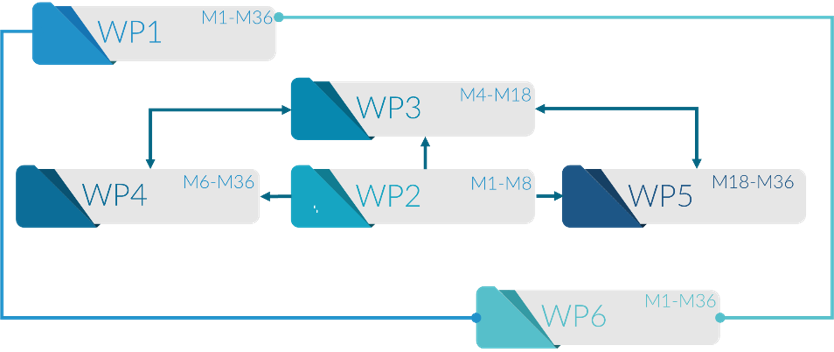The work planned in the CyberSecDome project will be carried out in six (6) work packages (WPs).
The project is structured in phases:
(i) Design, Development, and Integration Phase (WP2, WP3 & WP4):
Focuses on designing and developing the three major building blocks of the CyberSecDome approach.
(ii) Deployment and Evaluation Phase (WP5):
Involves the pilot operation and concurrent evaluation activities to assess outcomes. It will produce policy recommendations for public authorities, addressing regulatory aspects of cybersecurity, and evaluate legal and ethical issues.
(iii) Horizontal Activities (WP1 and WP6):
Encompass project management (WP1) and impact maximization (WP6) activities throughout the project duration. WP6 reports qualitative and quantitative results from real-field settings and assesses CyberSecDome’s impact.

WP 1 | Project Management
WP1 aims to establish and maintain the administrative, financial, and management infrastructure of the CyberSecDome project. Key objectives include effective project management, initiation of project phases, supervision of scientific and technical progress, monitoring of project development, and establishment of communication channels among partners. Additionally, WP1 focuses on continuous risk and opportunity management throughout the project, along with ensuring compliance with ethics, privacy, and data protection guidelines.
WP 2 | Requirements, Evaluation Metrics and Architecture
WP2 aims to analyze requirements for effective cybersecurity measures in digital infrastructures. Objectives include progress beyond the state-of-the-art solutions, stakeholder requirements analysis, defining use-cases and attack scenarios, addressing legal and ethical considerations, and proposing the high-level architecture and functional requirements of CyberSecDome.
WP 3 | Specifications and Development of AIEmpowered Security Tools
WP3 focuses on developing AI-empowered security tools for direct communication, ensuring cybersecurity in digital infrastructures and streaming network information. Key objectives include collecting and updating information on cybersecurity threats, live training of AI models, building modern AI intrusion detection and prediction modules, implementing tools for internal information analysis from specific incidents, developing AI pen-testing automation based on high-risk assessments, and creating an AI-based tool for dynamic responses and solutions to cybersecurity issues.
WP 4 | VR, XAI, Information Sharing and Integration of CyberSecDome
into the pilot CyberSecDome system. It includes developing an immersive user interface for cybersecurity tasks, enhancing understanding of AI operation, introducing knowledge sharing between CyberSecDome instances, implementing swarm learning for improved cybersecurity operations, and combining and maturing all components, including integration, testing, delivery, and tuning of the CyberSecDome.
WP 5 | Pilots’ Development and Evaluation of CyberSecDome
WP5’s main objective is to manage, design, and execute financial support for CyberSecDome to engage third parties. Specifically, it will develop an Open Call methodology to attract cross-sector and cross-border third parties to join CyberSecDome deliveries. The goal is to define and publish the Open Call, execute a transparent process for engaging external experts, and evaluate third-party proposals. The Open Call, conducted in two rounds, follows the project’s methodology, involving activities like specifying objectives, preparing and publishing actions, managing and assessing winning proposals, and continuously promoting Open Call evolution to wider audiences.
WP 6 | Dissemination, Exploitation and Sustainability
WP6 aims is to develop & execute a dissemination-communication strategy to maximise the visibility of CyberSecDome and its results, also develop the project exploitation strategy (including IPR definition) to ensure the sustainability and long-term impact of the technical and scientific outcomes and produce the business model canvases of the Key Exploitable Results (KERs). In addition, WP6 aims to monitor and follow the regulations and standards in the European landscape to promote CyberSecDome certification technology towards standardisation efforts. Finally, development of a business plan for the project’s tangible outcomes.
